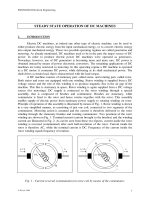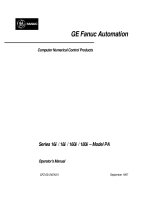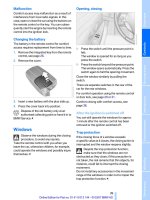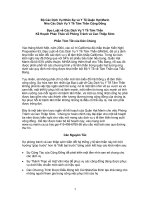Tài liệu Pickard’s Manual of Operative Dentistry pptx
Bạn đang xem bản rút gọn của tài liệu. Xem và tải ngay bản đầy đủ của tài liệu tại đây (13.1 MB, 224 trang )
OXFORD MEDICAL PUBLICATIONS
Pickard’s Manual of
Operative Dentistry
MOD8E-PRE(i-xiv) 11/11/03 11:56 AM Page i
Professor HM Pickard 1909–2002
MOD8E-PRE(i-xiv) 11/11/03 11:56 AM Page ii
Edwina A. M. Kidd
Professor of Cariology
Guy’s, King’s, and St Thomas’ Dental Institute
King’s College
London
Bernard G. N. Smith
Professor of Conservative Dentistry
Guy’s, King’s, and St Thomas’ Dental Institute
King’s College
London
Timothy F. Watson
Professor of Microscopy in Relation to Restorative Dentistry
Guy’s, King’s, and St Thomas’ Dental Institute
King’s College
London
Based on the first five editions of A manual of operative dentistry
H. M. Pickard
Emeritus Professor in Conservative Dentistry
University of London
Formerly of the Royal Dental Hospital of London School of Dental Surgery
Pickard’s Manual of
Operative Dentistry
Eighth edition
1
MOD8E-PRE(i-xiv) 11/11/03 11:56 AM Page iii
3
Great Clarendon Street, Oxford OX2 6DP
Oxford University Press is a department of the University of Oxford.
It furthers the University’s objective of excellence in research, scholarship,
and education by publishing worldwide in
Oxford New York
Auckland Bangkok Buenos Aires Cape Town Chennai
Dar es Salaam Delhi Hong Kong Istanbul Karachi Kolkata
Kuala Lumpur Madrid Melbourne Mexico City Mumbai Nairobi
Sao Paulo Shanghai Taipei Tokyo Toronto
Oxford is a registered trade mark of Oxford University Press
in the UK and in certain other countries
Published in the United States
by Oxford University Press Inc., New York
© Oxford University Press, 2003
The moral rights of the author have been asserted
Database right Oxford University Press (maker)
First edition published 1961
Sixth edition published 1990
Seventh edition published 1996 (reprinted 1996, 1998 (twice), 2000)
Eighth edition published 2003
All rights reserved. No part of this publication may be reproduced,
stored in a retrieval system, or transmitted, in any form or by any means,
without the prior permission in writing of Oxford University Press,
or as expressly permitted by law, or under terms agreed with the appropriate
reprographics rights organization. Enquiries concerning reproduction
outside the scope of the above should be sent to the Rights Department,
Oxford University Press, at the address above
You must not circulate this book in any other binding or cover
and you must impose this same condition on any acquirer
British Library Cataloguing in Publication Data
Data available
Library of Congress Cataloging in Publication Data
ISBN 0 19 850928 6
10987654321
Typeset by EXPO Holdings, Malaysia
Printed in China
on acid-free paper by
MOD8E-PRE(i-xiv) 11/11/03 11:56 AM Page iv
It is 41 years since the first edition of this book was pub-
lished. In that time there have been so many developments in
our understanding of dental disease, in materials, and in
techniques so that there is now very little of that first edition
remaining except the basic philosophy for managing
patients with dental disease. This philosophy has several
parallel threads which weave together.
• Dentists primarily look after people with dental prob-
lems – not just mouths or teeth.
• An understanding of the disease processes is funda-
mental to their management.
• The diseases should be managed – not just treated.
• Prevention is the keystone of management. The effect-
iveness of the prevention of dental caries in a selected
group is shown by the fact that about three-quarters of
undergraduate dental students at our dental institute
now have no caries or restorations. Sadly, this is not yet
the case with all people of that generation.
• When treatment is needed, the development of excel-
lent operative skills is still of paramount importance.
This can only be achieved by extensive supervised
clinical practice and chairside teaching which remain
as important as ever in the crowded undergraduate
curriculum. If students do not develop sufficient skill
during their undergraduate course there is little
opportunity for most dentists to develop basic skills in
a supervised setting after qualification.
• When active treatment is needed, the choice of mater-
ials and techniques should be based on a thorough
understanding of them and the advantages and dis-
advantages of the alternatives. This choice is getting
more difficult as the range of materials and techniques
increases so that an even greater understanding of the
properties of dental materials is now necessary.
One of the major developments since the seventh edition
has been the increased use of bonding techniques which in
turn allow much less destructive tooth preparation. For
example, in the seventh edition the use of amalgam for the
management of smooth surface lesions was deleted, and we
now feel that the evidence to support the use of composite
materials for occlusal lesions is sufficient for us to recom-
mend that amalgam should no longer be used for occlusal
restorations. These developments justify a new chapter
(Chapter 6) which brings together parts of other chapters
from the last edition and adds substantial new material.
The intention is that this book contains the material a
student needs to know (except endodontic and periodontal
treatment) up to the point that crowns become necessary. In
other words, students can provide long-term stabilization,
including permanent intracoronal restorations and cores for
crowns, until they have learnt about crowns and then can
continue treating the same patients if that is the policy of their
undergraduate school. An increasing number of schools adopt
policies of ‘whole patient care’ and ‘continuity of care’ so that
students can manage their own patients and all their dental
needs from an early introduction through to the end of the
undergraduate course. In some schools this gives the students
three or more years of contact with some patients at regular
recalls after the initial course of treatment. During that time
they can move on to other procedures, as necessary, with the
same patient, for example crowns, bridges, and partial
dentures. They also have an opportunity to see the short-term
(one or two years) success or failure of their restorations.
Previous editions have included a brief list of ‘further
reading’ at the end of each chapter. This has been brought
up to date and retained but we suggest that readers use the
list of topics at the beginning of each chapter as ‘keywords’
to initiate their own computer search of the literature.
There are two significant, current educational and clinical
concepts which we believe we have developed further in this
edition. The first is ‘problem solving’ and the emphasis on
managing disease rather than treating it as an example of real
problem solving. The second concept is ‘evidence-based prac-
tice’. This is a manual of operative dentistry, not an authori-
tative textbook, however many of the changes in this edition
are based on recent research evidence. If evidence is consid-
ered as not just research-based scientific evidence but
includes the evidence of experience, then we believe that this
edition reflects the current state of play in operative dentistry.
We are considerably indebted to many colleagues who
have allowed us to use their illustrations. They are acknow-
ledged in the captions to the relevant figures together with a
source of the original publication where applicable.
E. A. M. K.
B. G. N. S.
T. F. W.
March 2003
Preface to the eighth edition
MOD8E-PRE(i-xiv) 11/11/03 11:56 AM Page v
MOD8E-PRE(i-xiv) 11/11/03 11:56 AM Page vi
This page intentionally left blank
PART I DISEASES, DISORDERS, DIAGNOSIS,
DECISIONS, AND DESIGN
1 Why restore teeth? 5
Dental caries 5
The carious process and the carious lesion 6
Plaque retention and susceptible sites 6
Severity or rapidity of attack 7
The carious process in enamel 7
The carious process in dentine 9
Root caries 11
Secondary or recurrent caries 11
Residual caries 12
Diagnosis of dental caries 12
The diagnostic procedure 12
Assessment of caries risk 16
Symptoms of caries 18
The relevance of the diagnostic information to the
management of caries 18
Preventive, non-operative treatment 18
Patient involvement 19
Why is the patient a caries risk? 19
Mechanical plaque control 19
Use of fluoride 20
Dietary advice 20
Salivary flow 20
Operative treatment 20
Caries in pits and fissures 20
Approximal lesions 20
Smooth surfaces and root caries 20
Tooth wear 20
Erosion 22
Attrition 23
Abrasion 24
Summary of the causes of tooth wear 24
Acceptable and pathological levels of tooth wear 24
Consequences of pathological tooth wear 24
Diagnosing and monitoring tooth wear 24
Preventing tooth wear 27
The management of tooth wear 27
Contents
MOD8E-PRE(i-xiv) 11/11/03 11:56 AM Page vii
viii
Contents
Trauma 27
Aetiology of trauma 27
Examination and diagnosis of dental injury 28
Management of trauma to the teeth 28
Developmental defects 28
Acquired developmental conditions 28
Treatment of developmental defects 30
Hereditary conditions 30
Further reading 31
2 Making clinical decisions 35
Who makes the decisions? 35
Professionalism 35
Large and small decisions 36
The four main decisions 36
Diagnosis 36
Prognosis 36
Treatment options 36
Further preventive measures 34
The information needed to make decisions and how it is collected
and recorded 36
History 37
Examination 40
Examination of specific areas of the mouth 41
Detailed charts 42
Special tests 43
The history and examination process 45
Planning the treatment 46
Some common decisions which have to be made 47
Diagnosing toothache 47
Whether to restore or attempt to arrest a moderate-size carious
lesion and whether to restore or monitor an erosive lesion 50
Whether to extract or root treat a tooth 52
Which restorative material to use 52
Further reading 52
3 Principles of cavity design and preparation 55
G. V. Black 55
Why restore teeth? 55
What determines cavity design? 55
The dental tissues 55
The diseases 56
The properties of restorative materials 56
Resin composites 57
Composition of composites 58
Polymerization of composites 58
Glass ionomer cements 58
Conventional, autocuring, glass ionomer cements 59
Resin-modified glass ionomer cements (RMGIC) 59
Polyacid-modified resin composites (PAMRC) 59
Fluoride-releasing materials 59
Dental amalgam 60
Composition of amalgam alloys and their relevance to clinical
practice 60
MOD8E-PRE(i-xiv) 11/11/03 11:56 AM Page viii
The safety aspects of amalgam 61
Cast gold and other alloys 61
Principles of cavity design 62
When is a restoration needed? 62
Gaining access to the caries 62
Removing the caries 63
How should soft, infected dentine be removed? 63
Stepwise excavation 64
Put the instruments down: look, think, and design 64
The final choice of restorative material 64
Making the restoration retentive 64
Design features to protect the remaining tooth tissue 65
Design features to optimize the strength of the restoration 65
‘Resistance form’ 66
The shape and position of the cavity margin 66
Possible future developments in cavity design 66
The control of pain and trauma in operative dentistry 66
Pre-operative precautions 67
Pain and trauma control during tooth preparation 67
Avoiding postoperative pain 68
Cavity lining and chemical preparation 68
Objectives and materials 68
Further reading 69
PART II TREATMENT TECHNIQUES
4 The operator and the environment 75
The dental team 75
The dental school and practice environment 75
The surgery 76
Positioning the patient, the dentist, and the dental nurse 76
Lighting 77
Siting of work-surfaces and instruments 77
Aspirating equipment; cavity washing and drying 78
Hand and instrument cleaning 78
Close-support dentistry 78
Maintaining a clear working field for the dentist 78
Instrument transfer 79
Moisture control 80
Reasons for moisture control 80
Techniques for moisture control 80
Magnification 86
Protection, safety, and management of minor emergencies 88
Eye protection 88
Airway protection 88
Soft tissue protection 89
Avoiding surgical emphysema 89
Dealing with accidents and accident reporting 90
Protection from infection 90
Further reading 90
5 Instruments and handpieces 93
Hand instruments 93
Instruments used for examining the mouth and teeth 93
ix
Contents
MOD8E-PRE(i-xiv) 11/11/03 11:56 AM Page ix
x
Contents
Instruments used for removing caries and cutting teeth 94
Instruments used for placing and condensing restorative
materials 94
Hand instrument design 95
Using hand instruments 96
Maintaining hand instruments 96
Sharpening hand instruments 96
Decontaminating and sterilizing hand instruments 97
Rotary instruments 97
The air turbine 97
Low-speed handpieces 97
Maintaining and sterilizing handpieces 98
Burs and stones 98
Finishing instruments 99
Maintaining and sterilizing burs and stones 101
Tooth preparation with rotary instruments 101
Speed, torque, and ‘feel’ 101
Heat generation and dissipation 101
Effects on the patient 101
Choosing the bur for the job 102
Surface finish 102
Finishing and polishing restorations 102
Air abrasion 103
Auxiliary instruments and equipment 103
6 Bonding to tooth structure 107
Why bond to tooth tissue? 107
The substrate; enamel and dentine 107
Enamel 107
Dentine 108
Enamel–dentine junction 108
Cutting 109
Choice of materials for bonding techniques 109
Spectrum of bonding materials 109
Overall requirements for adhesion 109
Composites 110
Bonding to enamel 110
Bonding to dentine 110
Bonding to wet dentine (and enamel) 112
Important considerations on the use of bonding agents 113
Number of stages and film thickness 113
Speed of application 113
Good clear instructions 114
Ease of dispensing and handling 114
Sensitization 114
Shelf-life 114
Glass ionomer cements 114
Adhesion mechanisms: conventional glass ionomer
cements 114
Conditioning the dentine 115
Bonding glass ionomer cements to enamel 115
Bonding glass ionomer cements to dentine 116
The resin-modified glass ionomer cements 116
The polyacid-modified resin composites 117
MOD8E-PRE(i-xiv) 11/11/03 11:56 AM Page x
Bonded amalgam restorations 117
Further reading 118
7 Treatment of pit and fissure caries 121
Introduction 121
Fissure sealing 121
Indications 121
Clinical technique for resin sealers 122
Clinical technique for glass ionomer cement sealers 123
The sealant restoration (or preventive resin restoration) 124
Indications 124
Clinical technique 124
Larger posterior composites 127
Amalgam restorations for pit and fissure caries 127
Further reading 128
8 Treatment of approximal caries in posterior teeth 131
Introduction 131
Approximal amalgam restorations: access through the marginal
ridge 131
Pre-operative procedures 131
Access to caries and clearing the enamel–dentine junction 133
Finishing the enamel margins 133
Removing caries over the pulp 133
Retention 134
Lower premolars 135
Lining the cavity 135
Applying the matrix band 135
Choice of amalgam 137
Inserting the amalgam 137
Carving and finishing the amalgam 137
Polishing 138
Approximal composite restorations: access through the marginal
ridge 138
Indications 138
Aspect of cavity preparation 139
Lining and etching the cavity 139
Placing the matrix and restoration 139
Finishing the restoration 143
Approximal ‘adhesive’ restorations: marginal ridge
preserved 143
Occlusal approach 143
Buccal approach 144
Approximal root caries 145
The mesial–occlusal–distal (MOD) cavity 145
Problems of the larger cavity 145
Pre-operative assessment 146
Caries removal 146
Desining the restoration 146
Choice of restorative material 147
Bonded amalgam restorations 148
Pin retention for large restorations and cores 148
Placing the matrix, packing, carving, and finishing 150
Further reading 151
xi
Contents
MOD8E-PRE(i-xiv) 11/11/03 11:56 AM Page xi
xii
Contents
9 Treatment of smooth surface caries, erosion–abrasion lesions,
and enamel hypoplasia 155
Smooth surface enamel caries 155
Root caries 155
Restoration of free smooth surface carious lesions (both enamel
and root caries) 156
Access to caries 156
Removal of caries 157
Choice of restorative material 157
Lining 158
Applying the matrix and placing the restoration 158
Finishing 159
Erosion–abrasion lesions 159
Choice of restorative material for erosion–abrasion
lesions 161
Cavity preparation, lining, and filling 161
Enamel hypoplasia 161
Summary of the choice of restorative materials for smooth
surface lesions 161
10 Treatment of approximal caries, trauma, developmental
disorders, and discoloration in anterior teeth 165
Conditions affecting anterior teeth which may need
restorations 165
Approximal caries 165
Approximal caries which also involves the incisal edge 165
Trauma 165
Developmental disorders 166
Discoloured teeth 166
Tooth wear 166
Treatment options 166
Uses and limitations of anterior composite materials 166
Retention of composite to dentine 166
Porcelain veneers 166
Examples of anterior restorations 167
Restoration of approximal caries in an anterior tooth 167
Composite restorations involving the incisal edge 169
Veneering techniques for hypoplastic and discoloured
teeth 171
Bleaching discoloured anterior teeth 172
Further reading 173
11 Indirect cast metal, porcelain, and composite intracoronal
restorations 177
Plastic compared with rigid restorations 177
The lost wax process 177
Intracoronal and extracoronal restorations 177
Materials 177
Cast metal 177
Porcelain 178
Advantages and disadvantages of cast metal and porcelain
restorations 179
Strength 179
Abrasion resistance 179
MOD8E-PRE(i-xiv) 11/11/03 11:56 AM Page xii
Appearance 179
Versatility 179
Cost 179
The cement lute 180
Indications 180
Preparations and clinical techniques 181
Indirect cast metal inlay 181
Porcelain inlay 184
Porcelain veneer 186
Further reading 187
PART III MONITORING AND MAINTENANCE
12 The long-term management of patients with restored
dentitions 193
Introduction 193
How long do restorations last? 193
The ways in which restorations fail 194
New disease 194
Technical failure 198
Acceptable and unacceptable deterioration or failure 200
The patient’s perception of the problem 200
The dentist’s assessment of the effect of technical failure 200
Monitoring techniques: recall and reassessment 201
Frequency of recall 201
The recall assessment 202
Techniques for removal, adjustment, and repair 202
Amalgam 202
Composite and glass ionomer cement 203
Cast metal and ceramic restorations 204
Removal of ledges 204
Further reading 204
Index 205
xiii
Contents
MOD8E-PRE(i-xiv) 11/11/03 11:56 AM Page xiii
MOD8E-PRE(i-xiv) 11/11/03 11:56 AM Page xiv
This page intentionally left blank
PART I
DISEASES, DISORDERS,
DIAGNOSIS, DECISIONS,
AND DESIGN
MOD8E_01(1-32) 11/11/03 11:49 AM Page 1
MOD8E_01(1-32) 11/11/03 11:49 AM Page 2
This page intentionally left blank
Why restore teeth?
Dental caries
• The carious process and the carious lesion
• Plaque retention and susceptible sites
• Severity or rapidity of attack
• The carious process in enamel
• The carious process in dentine
• Root caries
• Secondary or recurrent caries
• Residual caries
Diagnosis of dental caries
• The diagnostic procedure
• Assessment of caries risk
• Symptoms of caries
• The relevance of the diagnostic information to the
management of caries
Preventive, non-operative treatment
• Patient involvement
• Why is the patient a caries risk?
• Mechanical plaque control
• Use of fluoride
• Dietary advice
• Salivary flow
1
MOD8E_01(1-32) 11/11/03 11:49 AM Page 3
Operative treatment
• Caries in pits and fissures
• Approximal lesions
• Smooth surfaces and root caries
Tooth wear
• Erosion
• Attrition
• Abrasion
• Summary of the causes of tooth wear
• Acceptable and pathological levels of tooth wear
• Consequences of pathological tooth wear
• Diagnosing and monitoring tooth wear
• Preventing tooth wear
• The management of tooth wear
Trauma
• Aetiology of trauma
• Examination and diagnosis of dental injury
• Management of trauma to the teeth
Developmental defects
• Acquired developmental conditions
• Treatment of developmental defects
• Hereditary conditions
MOD8E_01(1-32) 11/11/03 11:49 AM Page 4
The four conditions which result in defective tooth structure,
sometimes requiring repair, are dental caries, tooth wear,
trauma and developmental defects. This chapter discusses the
causes, diagnosis, and management of these conditions.
A clear understanding of the conditions is essential if the
dentist is to plan and execute treatment logically, effectively,
and in the patient’s best interests. Indeed, unless the dentist
understands the processes it will not be possible to decide
whether treatment is necessary at all.
Dental caries
Dental caries is a process which may take place on any tooth
surface in the oral cavity where a microbial biofilm (dental
plaque) is allowed to develop for a period of time. Although
there are some 300 bacterial species in dental plaque, it is
not a haphazard collection of micro-organisms. It is an
ordered accumulation forming a community with a collect-
ive physiology.
The bacteria in the biofilm are always metabolically
active, causing minute fluctuations in pH. These may cause
a net loss of mineral from the tooth when the pH is dropping.
This is called demineralization. Alternatively there may be a
net gain of mineral when the pH is increasing. This is called
remineralization. The cumulative result of these de- and
remineralization processes may be a net loss of mineral and
a carious lesion which can be seen. Alternatively the
changes may be so slight that a carious lesion never becomes
apparent (Fig. 1.1).
The carious process is the metabolic activity in the
biofilm. This is an ubiquitous, natural process because the
formation of the biofilm and its metabolic activity cannot be
prevented. However, disease progression can be controlled so
that a clinically visible enamel lesion never forms. The de-
and remineralization processes can be modified particularly
by regular disturbance of the biofilm with a toothbrush and
fluoride toothpaste. If the biofilm is partially or totally
removed mineral loss may be stopped or even reversed
towards mineral gain. The fluoride in the toothpaste delays
lesion progression by inhibiting demineralization and
encouraging remineralization.
Diet plays a significant role in the carious process because
the bacteria in the biofilm are capable of fermenting a suitable
dietary carbohydrate substrate (such as the sugars sucrose
and glucose) to produce acid, causing the plaque pH to fall
within 1–3 minutes. Unfortunately the plaque remains acid
for some time, taking 30–60 minutes to return to its normal
pH in the region of 7. The buffering capacity of saliva is
important in this return to neutrality and this means that
anyone with a dry mouth is very susceptible to caries. These
Why restore teeth?
Fig. 1.1 The upper anterior teeth of a young adult. In the upper picture a
disclosing agent reveals the plaque or biofilm while in the lower picture
this has been brushed off by the patient. White spot lesions are visible on
the canines and lateral incisors but not on other tooth surfaces although
plaque was present.
Fig. 1.2 Changes in plaque pH following a glucose rinse (‘Stephan curve’).
MOD8E_01(1-32) 11/11/03 11:49 AM Page 5
6
1 Why restore teeth?
changes in pH can be represented graphically over a period of
time following a glucose rinse (Fig. 1.2).
The carious process and the carious lesion
Carious lesions can form on any tooth surface exposed to the
mouth; thus they can form on enamel, cementum, or dent-
ine. It is perhaps unfortunate that the word ‘caries’ is used to
denote both the carious process that occurs in the biofilm at
the tooth or cavity surface and the carious lesion that forms
on the tooth tissue.
The carious lesion forms as a direct consequence of the
activity in the biofilm but this activity cannot be seen; it is
the consequence of the carious process that the dentist sees
and describes as a carious lesion.
Plaque retention and susceptible sites
Any site on the tooth surface that favours plaque retention
and stagnation is prone to decay. The following sites partic-
ularly favour plaque retention:
•
enamel pits and fissures on occlusal surfaces of molar
and premolar teeth (Fig. 1.3); buccal pits of molars and
palatal pits of maxillary incisors
•
approximal enamel smooth surfaces just cervical to
the contact area (Fig. 1.4)
•
the enamel at the cervical margin of the tooth at the gin-
gival margin (Fig. 1.5). In patients with gingival reces-
sion, the area of plaque stagnation is on the exposed root
surface (Fig.1.6)
•
the margins of restorations, particularly where there
is a wide gap between the restoration and the tooth or
those where the restoration overhangs the margin of
the cavity (Fig.1.7).
In younger age groups pit and fissure caries is more com-
mon than approximal caries and buccal and lingual caries;
posterior approximal caries is more common than anterior
approximal caries. However, in older patients root surfaces
exposed by gingival recession may be the predominant site
for caries to occur.
Caries at the margins of a restoration should be, in a per-
fect world, the least common lesion. However, while placing
a filling may make it easier for a patient to clean because the
‘hole’ is now restored, the filling will not prevent the biofilm
Fig. 1.3 Occlusal caries in a lower first molar tooth.
Fig. 1.4 A carious lesion is present on the distal aspect of the first
premolar tooth. The lesion is shining through the marginal ridge which
shows a pinkish grey discoloration.
Fig. 1.5 White spot enamel lesions at the cervical margins of both
molar teeth.
Fig. 1.6 Caries on the exposed buccal root surface of the first premolar
tooth.
Fig. 1.7 Caries at the margin of the occlusal restoration in the first molar
tooth.
MOD8E_01(1-32) 11/11/03 11:49 AM Page 6
forming on the tooth tissue next to it. Unless this is regular-
ly disturbed by the patient, a new lesion will develop. It is all
too easy to forget that the ‘action’ is in the biofilm and the
lesion, which may have been removed and replaced by a
filling, merely reflected the activity of the biofilm – unless
restoration of the tooth has needlessly enlarged the cavity.
Severity or rapidity of attack
Under normal conditions the tooth is continually bathed in
saliva which is capable of remineralizing the early carious
lesion because it is supersaturated with calcium and
phosphate ions.
Dental caries may be classified according to the severity or
rapidity of the attack, and different teeth and surfaces are
involved depending on the severity. Thus in a mild case only
the most vulnerable teeth and surfaces are attacked, such as
occlusal pits and fissures. A moderate attack may involve
occlusal and approximal surfaces of posterior teeth and in a
severe attack buccal and lingual surfaces close to the gingi-
val margin and anterior teeth, which otherwise remain
caries-free, also become carious.
Rampant caries
Rampant caries is the term used to describe a sudden rapid
destruction of many teeth, frequently involving surfaces of
teeth that are ordinarily relatively caries-free. Rampant
caries is most commonly observed in the primary dentition
of infants who continually suck a bottle or comforter con-
taining, or dipped into, a sugar solution (Fig. 1.8). Rampant
caries may also be seen in the permanent dentition of
teenagers and is usually due to frequent cariogenic snacks
7
Dental caries
and sweet drinks between meals (Fig. 1.9). It is also seen in
mouths where there is a sudden marked reduction in sali-
vary flow (xerostomia). Radiation in the region of the sali-
vary glands, used in the treatment of a malignant growth,
and Sjögren’s syndrome, an autoimmune condition which
may involve the salivary glands, are the most common caus-
es of severe xerostomia. In addition, a large number of
therapeutic drugs, such as antidepressants, tranquillizers,
antihypertensives, and diuretics, retard salivary flow.
The management of rampant caries is more difficult than
the management of caries which has progressed at a slower
pace because of the extent of the caries and the rate at
which it progresses. However, the treatment is the same in
principle. The disease is managed by preventing further dis-
ease progression and stabilizing existing lesions before
restoring teeth permanently. If caries is not managed by pre-
ventive, non-operative treatment the restorative treatment
will be doomed to a cycle of disease, repair, new disease and
further repair, and, before too long, extraction.
Arrested caries
Arrested caries is in distinct contrast to rampant caries, and
the term describes carious lesions which do not progress. It
is seen when the oral environment has changed from condi-
tions predisposing to caries to conditions that tend to slow
the lesion down. Figure 1.10 shows an arrested lesion on the
mesial aspect of a lower second molar. The lesion probably
stopped after extraction of the first molar. The environment
changed, becoming less plaque retentive, easier to clean,
and more accessible to saliva. Operative treatment is clearly
not necessary.
Fig. 1.8 Rampant caries of the deciduous teeth. This child continuously
sucked a bottle of sweet drink.
Fig. 1.9 Rampant caries in a 19-year-old man.
Fig. 1.10 Arrested caries on the mesial aspect of the second molar tooth.
This lesion probably stopped progressing after extraction of the first molar
tooth.
The carious process in enamel
The earliest clinically visible evidence of enamel caries is the
white spot lesion, for example at the cervical margin of the
tooth (Fig. 1.5). This may also be seen on extracted teeth as
a small opaque white area just cervical to where the approx-
imal contact area was. The colour of the lesion distinguish-
es it from the adjacent sound enamel, but at this stage there
MOD8E_01(1-32) 11/11/03 11:49 AM Page 7
8
1 Why restore teeth?
is no cavity and the enamel overlying the white spot is hard. In
the active lesion it may have a matt surface because there has
been direct dissolution of the outer enamel surface. Sometimes
the lesion is shiny and this would indicate that good plaque
control has been re-established and the outer demineralized
enamel has been worn away. This lesion is arrested and some-
times it may appear brown due to exogenous stains absorbed
by this porous region. Both white and brown spot lesions may
have been present in the mouth for some years, as it is not
inevitable for a carious lesion to progress.
If this smooth surface lesion is examined histologically
in a thin ground section with transmitted light, it is usual-
ly seen to be cone-shaped, with the apex of the cone point-
ing towards the enamel–dentine junction (Fig. 1.11). The
shape of the white spot lesion is determined by the distrib-
ution of the biofilm and the direction of the enamel prisms.
Thus on an approximal surface the lesion formed beneath
the biofilm is a kidney-shaped area between the contact
facet and the gingival margin. Within the enamel, spread
of dissolution takes place along the enamel prisms. The
conical shape of the smooth surface lesion is the result of
systematic variations in dissolution along the enamel
prisms. The oldest or most active part of the lesion is cen-
trally where the lesion is deepest. The conical shape repre-
sents increasing stages of lesion progression beginning
with dissolution that would only be seen at the ultrastruc-
tural level at the edge of the lesion. This emphasizes that
the lesion is driven by, and reflects, the specific environ-
mental conditions in the overlying biofilm. One important
feature of the histological picture is that the early enamel
lesion is a subsurface demineralization beneath a relative-
ly intact surface zone.
If the early enamel lesion progresses, the intact surface
breaks down, forming a physical defect in the surface (cav-
itation). Plaque formation continues within the cavity and
this may not be accessible to cleaning aids such as a tooth-
brush or dental floss. For this reason a cavitated lesion is
more likely to progress, although it can still become arrest-
ed if the patient is able to clean.
Fig. 1.13 The surface of the tooth seen in Fig. 1.12 has now been
brushed to remove all plaque and thoroughly dried. A white spot lesion is
now obvious at the entrance to the fissures. (By courtesy of Dental
Update.)
Fig. 1.14 The correct position of the toothbrush on an erupting second
permanent molar. (By courtesy of Dental Update.)
Fissures and pits are obvious stagnation areas where
plaque can form and mature. The lesion forms at the
entrance to the fissure (Figs. 1.12 and 1.13), and the erupt-
ing tooth is particularly susceptible to plaque stagnation.
There are two reasons for this. The first is that children, espe-
cially young children, are not adept at removing plaque.
Secondly the erupting tooth is below the line of the arch and
tooth-brushing misses it unless the brush is brought in at
right angles to clean the surface specifically (Fig. 1.14).
Fig. 1.11 Longitudinal ground section through a carious lesion on a
smooth surface examined in water with polarized light. The lesion is cone-
shaped. Note the relatively intact surface zone (SZ).
Fig. 1.12 This erupting molar appears caries-free but it is not. (By
courtesy of Dental Update.)
MOD8E_01(1-32) 11/11/03 11:49 AM Page 8
9
Dental caries
The histological features of fissure caries are similar to
those already described for smooth surfaces. The lesion
forms around the fissure walls and gives the appearance in
section of two small smooth surface lesions (Fig. 1.15). The
lesions again follow the direction of the enamel prisms and
this anatomy gives the lesion the shape of a cone with its
base at the enamel–dentine junction (Fig. 1.16).
The carious process in dentine
Histologically, the carious process may be in dentine before
an enamel cavity forms. On an occlusal surface the lesion
widens as it approaches the enamel–dentine junction, guid-
ed by prism direction. Eventually a cavity forms and now the
hole is filled with plaque and the biofilm sits directly on the
exposed dentine. At this stage demineralization spreads lat-
erally along the enamel -dentine junction, undermining the
enamel (Fig. 1.17).
Undermined enamel is brittle and will in due course fracture
if subjected to occlusal forces, producing a large cavity.
Undermined enamel is of particular relevance in cavity prepa-
ration because superficially sound but undermined enamel
Fig. 1.16 (a) A molar tooth with a white spot lesion formed in an area of
plaque stagnation at the fissure entrance.
(b) A hemisection of this tooth showing a larger lesion than would be
expected from examination of the outer enamel surface. This is purely a
function of the direction of the enamel prisms in this region. (By courtesy of
Dental Update.)
(a)
(b)
Fig. 1.17 (a) A molar tooth with a cavity whose base is in dentine.
(b) A hemisection of this tooth showing the cavity and lateral spread of
the lesion at the enamel–dentine junction. There is extensive
demineralization of the dentine. This wide undermining of the enamel on
an occlusal surface is a factor of the anatomy of the area. (By courtesy of
Dental Update.)
(a)
(b)
Fig. 1.15 A longitudinal ground section through an occlusal fissure
showing a small carious lesion in enamel. The section is in water and
viewed in polarized light. The lesion forms on the fissure walls, giving the
appearance of two smooth surface lesions.
MOD8E_01(1-32) 11/11/03 11:49 AM Page 9
10
1 Why restore teeth?
must often be removed to gain access to demineralized dentine
beneath it. In addition, it is probably unwise to leave under-
mined enamel occlusally unless it is supported by an adhesive
restorative material.
Pulp–dentine defence reactions
Dentine is a vital tissue containing the cytoplasmic extensions
of the odontoblasts and must be considered together with the
pulp since the two tissues are so intimately connected. The
pulp–dentine complex, like any other vital tissue in the body, is
capable of defending itself. The state of the tissue at any time
will depend on the balance between the attacking forces and
the defence reactions. The important defence reactions are
tubular sclerosis within the dentine, reactionary dentine at
the interface between dentine and pulp, and inflammation of
the pulp.
Tubular sclerosis occurs through precipitation of minerals
in the tubular space and is protective in that it reduces the per-
meability of the dentine, inhibiting the penetration of acids
and bacterial toxins. Reactionary dentine is formed by the
odontoblasts beneath the carious stimulus. A slowly progress-
ing lesion may give time for a considerable reparative dentine
response, whereas with more acute larger lesions the response
may be disorganized or even non-existent. Regular removal of
the biofilm from the surface of any lesion encourages lesion
arrest and these defense reactions then predominate. This
retreat of the pulp from injury has important implications in
the operative management of caries (see p. 64).
Inflammation is the fundamental response of all vascular
connective tissues to injury. Inflammation of the pulp (pul-
pitis) may, as in any other tissue, be acute or chronic. In a
slowly progressing carious lesion, toxins reaching the pulp
may provoke chronic inflammation. However, once the
organisms actually reach the pulp (a carious exposure),
acute inflammation may supervene.
Inflammatory reactions have vascular and cellular compo-
nents. In chronic inflammation the cellular components pre-
dominate and there may be increased collagen production,
leading to fibrosis but without immediately endangering the
vitality of the tooth. However, in acute inflammation the vas-
cular changes predominate.
Infection is the most common cause of pulpal inflamma-
tion and caries is the most common microbial source. Caries
of peripheral dentine will result in pulpal inflammation and
chronic inflammatory cells (macrophages, lymphocytes,
and plasma cells) will infiltrate the pulp near the odontoblast
layer. Indeed, this infiltration may even be seen in initial
enamel caries. This chronic inflammatory reaction is main-
ly due to the movement of bacterial toxins through the
dentinal tubules. With increasing carious involvement of
enamel and dentine, the area of chronic inflammation
increases in size but it is believed to remain localized until
pulp exposure. After exposure, bacteria may enter the pulp.
Polymorphonuclear leucocytes may now predominate, and
acute inflammation can supervene and spread throughout
the pulp, resulting in pulpal necrosis.
One objective of the preparation of a carious cavity for a
filling is to remove the bacterial biofilm that drives the cari-
ous process before carious exposure occurs. Once the bacte-
rial irritant is removed, the local inflammation it has caused
has an inherent potential to heal provided that the cavity is
restored with a non-irritating material that seals the margin
of the filling and the pulp still has an adequate blood supply.
The age of the tooth will have some bearing on this: a young
tooth with a good blood supply is more likely to recover from
inflammation than an old tooth with more fibrous tissue
within the pulp chamber and a constricted blood supply. The
cavity seal prevents further bacterial ingress and assault on
the pulp–dentine complex.
However, if the operative procedure is performed in a man-
ner that is harmful to the pulp or the restorative material is a
poor cavity seal, irritating or defective, a local necrosis in the
pulp can result. The area of necrosis may harbour bacteria
and the inflammation may move apically until the entire pulp
is necrotic. This is followed either by spread of toxins into the
periapical tissues at the root apex, producing the chronic
inflammatory response of chronic apical periodontitis, or, if
organisms pass into the periapical tissues, an acute apical
abscess develops (see p. 47, 48).
Degenerative or destructive changes in dentine
These include demineralization of dentine, destruction of
the organic matrix, and damage and death of odontoblasts.
Since carious enamel is porous, acids, enzymes, and other
chemical stimuli from the tooth surface will reach the outer
dentine, evoking a response in the pulp–dentine complex.
Thus, both reparative and degenerative changes begin
before cavitation of the enamel occurs and while the micro-
organisms are still confined to the tooth surface. With cavi-
tation of enamel, bacteria have direct access to dentine and
the tissue becomes infected.
Demineralization of dentine precedes bacterial penetra-
tion, and this is of importance in operative dentistry since an
objective is to remove the infected and necrotic dentine,
although uninfected but demineralized dentine may be left.
Of course, this is easier said than done because it is difficult
to differentiate between the two layers. Thus, where the pulp is
not at risk or the strength of the tooth is not jeopardized, all the
soft, infected dentine is removed. However, if the carious den-
tine is close to the pulp, it is often left if it is reasonably hard,
even though it may contain a few organisms. These remaining
organisms are then sealed within the tooth. This encourages
tubular sclerosis and reparative dentine formation. This is
discussed further in Chapters 3 and 7.
It is important to realize that the rate of progress of caries
in dentine is highly variable and provided the biofilm is
MOD8E_01(1-32) 11/11/03 11:49 AM Page 10









